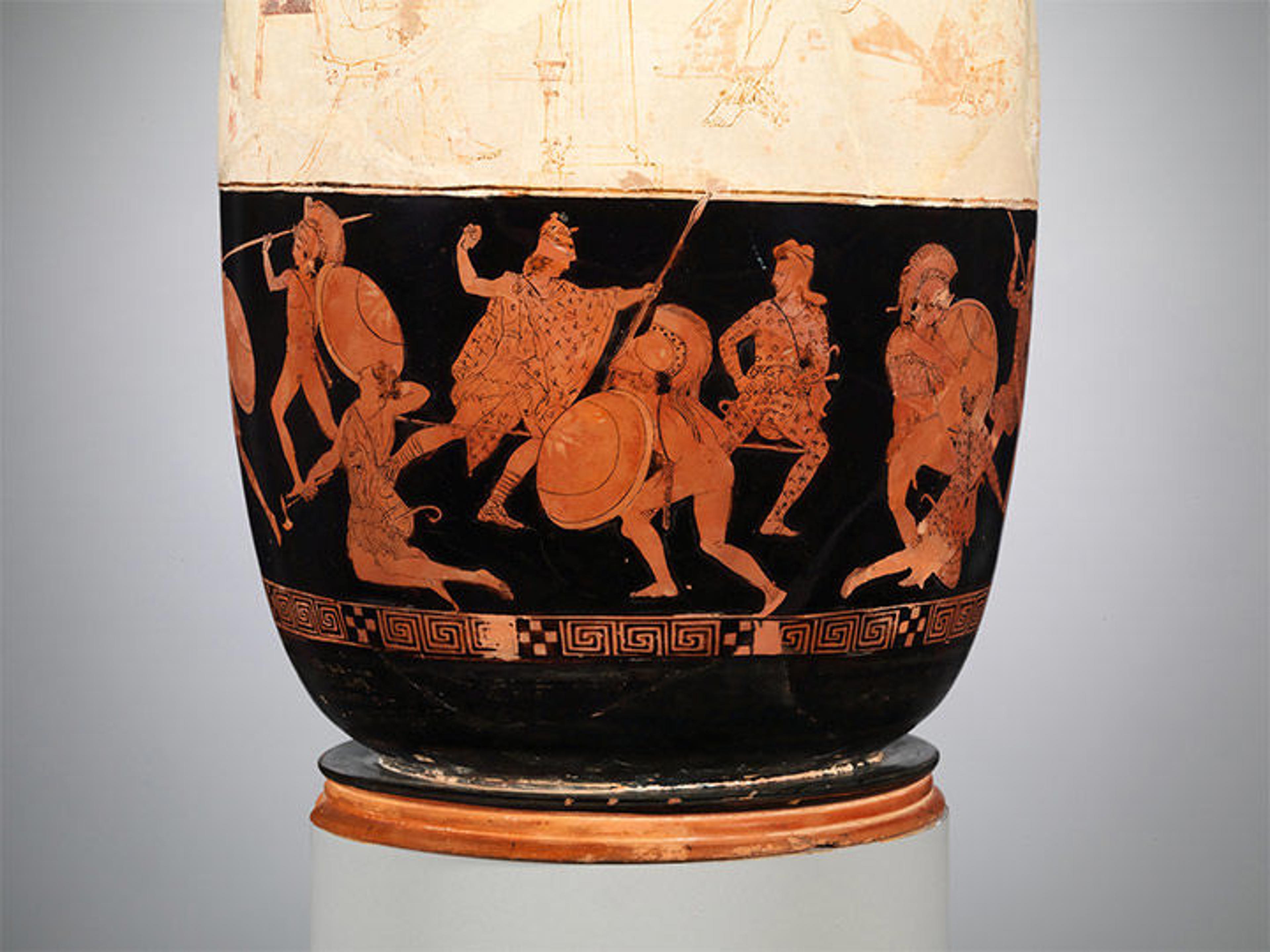What kinds of stories do you share with your family, friends, or classmates? Are they stories about things you've done? Stories other people have shared with you? Stories from your imagination?
The ancient Greeks shared myths—stories about the adventures of superhuman beings such as gods and heroes. They used myths to give accounts of their past history. Greek citizens went to theaters to watch plays based on myths. Greek artists painted scenes from myths on walls, vases, jars, and cups. The ancient Greek vase above, known as a krater, shows a scene from a myth about Amazons, or women warriors, battling the Greeks. Learn how to read what's happening on the vase and discover the story behind the battle.
Who's who?
Look at the lower scene on the ancient Greek vase. How can we tell who's who? There are a couple of ways to investigate. One way is to look closely at the characters and how they are dressed. What are the similarities and differences in the clothes they wear?
The two male foot soldiers (called hoplites) in the center are holding shields decorated with laurel wreaths. Notice the trousers of the two women on the right, the tunic worn by the woman mounted on the horse, and the shield held by the woman on the far left. All the female warriors are wearing or carrying something patterned. These women are Amazons from the mythical land of Scythia to the north and east of Greece. Their clothing looks similar to styles that came from Persia, an empire to the east of Greece.

Detail of the base of the terracotta volute-krater
What's happening?
The Amazons are battling the Athenians. Theseus, the mythical king of Athens, is in the center, holding a black shield on his left arm and a spear in his right hand. We don't know if the Amazon on the horse is Antiope or her sister Hippolyte.
Why are the Greeks and Amazons fighting?
Have you ever played the game telephone? A group of people sit in a circle. One person whispers something into another person's ear. Then the message is passed from person to person in whispers. The last person to receive the message tells the group what they heard. Almost always, it's different from what the first person said. This is because the message changed a little each time a new person repeated it. The ancient Greek myths that researchers study often tell the same story in different ways. This is because ancient authors and artists didn't always tell the same myth in the same way.
According to one myth, Theseus married Antiope, queen of the Amazons. Some versions of this myth explain that Theseus stole Antiope. Other versions tell us that Antiope fell in love with Theseus. In both scenarios, the Amazons were not happy that their queen was gone. The Amazons wanted Antiope back, but the Athenians did not want to let her go. The Amazons fought the Athenians to win back their queen
The ancient Greeks shared many different myths about battles with the Amazons. Stories about the Greeks and Amazons can be found on the Parthenon and the Temple of Hephaistos in Athens, Greece. And there's more than one Greek artwork at The Met that depicts the Amazons! Below is a terracotta lekythos (oil flask) that shows Hippolyte and the Amazons fighting Theseus and the Greeks.

Terracotta lekythos (oil flask), ca. 420 B.C. Greek, Attic, Classical. Terracotta; red-figure, white-ground, H. 19 1/2 in. (49.5 cm), D. 8 in. (20.5 cm). The Metropolitan Museum of Art, New York, Rogers Fund, 1931 (31.11.13)
In another Greek myth, Herakles (you may know him as Hercules) had to complete twelve labors—difficult tasks—for a king. For his ninth labor, Herakles had to steal a magical belt from the Amazon Hippolyte. The belt was a gift to Hippolyte from her father Ares, the god of war. In some versions of this myth, Theseus helped Herakles get the belt. At first the task was easy. Hippolyte respected Herakles because he had superhuman strength, so she gave Herakles her belt. Later, a rumor spread that the Athenians wanted to steal Hippolyte herself! The Amazons wanted to protect their queen, Hippolyte, so they began to fight Herakles and Theseus.
Theseus and the Greeks won both battles against the Amazons. Write your own ending. How will you resolve the conflict between the Amazons and the Greeks? Ask an adult to share your ideas in the comments below.
Get inspired! Here's one alternate ending made by kids as part of a #MetKids Animation Lab.
This stop-motion animation was made as part of a #MetKids Animation Lab. Kids explored the theme of "Jumping into The Met" by examining works of art on display in the galleries and creating their own narratives using stop-motion animation.
